Srikanta Bedathur
Learning Sparse Disentangled Representations for Multimodal Exclusion Retrieval
Apr 04, 2025Abstract:Multimodal representations are essential for cross-modal retrieval, but they often lack interpretability, making it difficult to understand the reasoning behind retrieved results. Sparse disentangled representations offer a promising solution; however, existing methods rely heavily on text tokens, resulting in high-dimensional embeddings. In this work, we propose a novel approach that generates compact, fixed-size embeddings that maintain disentanglement while providing greater control over retrieval tasks. We evaluate our method on challenging exclusion queries using the MSCOCO and Conceptual Captions benchmarks, demonstrating notable improvements over dense models like CLIP, BLIP, and VISTA (with gains of up to 11% in AP@10), as well as over sparse disentangled models like VDR (achieving up to 21% gains in AP@10). Furthermore, we present qualitative results that emphasize the enhanced interpretability of our disentangled representations.
Exploring the Use of LLMs for SQL Equivalence Checking
Dec 07, 2024Abstract:Equivalence checking of two SQL queries is an intractable problem encountered in diverse contexts ranging from grading student submissions in a DBMS course to debugging query rewriting rules in an optimizer, and many more. While a lot of progress has been made in recent years in developing practical solutions for this problem, the existing methods can handle only a small subset of SQL, even for bounded equivalence checking. They cannot support sophisticated SQL expressions one encounters in practice. At the same time, large language models (LLMs) -- such as GPT-4 -- have emerged as power generators of SQL from natural language specifications. This paper explores whether LLMs can also demonstrate the ability to reason with SQL queries and help advance SQL equivalence checking. Towards this, we conducted a detailed evaluation of several LLMs over collections with SQL pairs of varying levels of complexity. We explored the efficacy of different prompting techniques, the utility of synthetic examples & explanations, as well as logical plans generated by query parsers. Our main finding is that with well-designed prompting using an unoptimized SQL Logical Plan, LLMs can perform equivalence checking beyond the capabilities of current techniques, achieving nearly 100% accuracy for equivalent pairs and up to 70% for non-equivalent pairs of SQL queries. While LLMs lack the ability to generate formal proofs, their synthetic examples and human-readable explanations offer valuable insights to students (& instructors) in a classroom setting and to database administrators (DBAs) managing large database installations. Additionally, we also show that with careful fine-tuning, we can close the performance gap between smaller (and efficient) models and larger models such as GPT, thus paving the way for potential LLM-integration in standalone data processing systems.
Robust Training of Temporal GNNs using Nearest Neighbours based Hard Negatives
Feb 14, 2024Abstract:Temporal graph neural networks Tgnn have exhibited state-of-art performance in future-link prediction tasks. Training of these TGNNs is enumerated by uniform random sampling based unsupervised loss. During training, in the context of a positive example, the loss is computed over uninformative negatives, which introduces redundancy and sub-optimal performance. In this paper, we propose modified unsupervised learning of Tgnn, by replacing the uniform negative sampling with importance-based negative sampling. We theoretically motivate and define the dynamically computed distribution for a sampling of negative examples. Finally, using empirical evaluations over three real-world datasets, we show that Tgnn trained using loss based on proposed negative sampling provides consistent superior performance.
Navigating the Structured What-If Spaces: Counterfactual Generation via Structured Diffusion
Dec 21, 2023
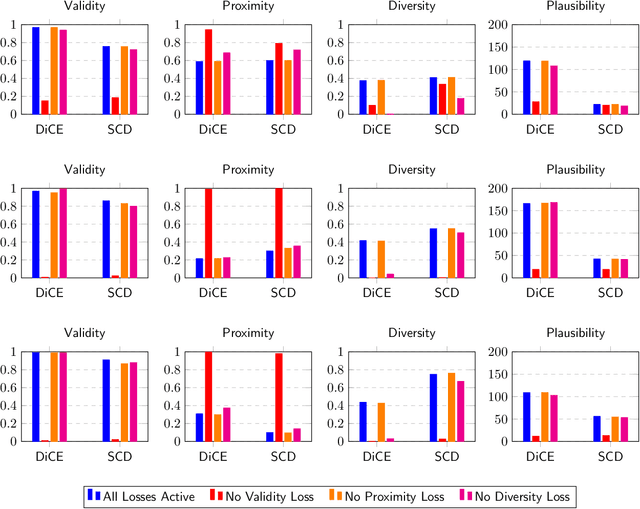


Abstract:Generating counterfactual explanations is one of the most effective approaches for uncovering the inner workings of black-box neural network models and building user trust. While remarkable strides have been made in generative modeling using diffusion models in domains like vision, their utility in generating counterfactual explanations in structured modalities remains unexplored. In this paper, we introduce Structured Counterfactual Diffuser or SCD, the first plug-and-play framework leveraging diffusion for generating counterfactual explanations in structured data. SCD learns the underlying data distribution via a diffusion model which is then guided at test time to generate counterfactuals for any arbitrary black-box model, input, and desired prediction. Our experiments show that our counterfactuals not only exhibit high plausibility compared to the existing state-of-the-art but also show significantly better proximity and diversity.
Retrieving Continuous Time Event Sequences using Neural Temporal Point Processes with Learnable Hashing
Jul 13, 2023Abstract:Temporal sequences have become pervasive in various real-world applications. Consequently, the volume of data generated in the form of continuous time-event sequence(s) or CTES(s) has increased exponentially in the past few years. Thus, a significant fraction of the ongoing research on CTES datasets involves designing models to address downstream tasks such as next-event prediction, long-term forecasting, sequence classification etc. The recent developments in predictive modeling using marked temporal point processes (MTPP) have enabled an accurate characterization of several real-world applications involving the CTESs. However, due to the complex nature of these CTES datasets, the task of large-scale retrieval of temporal sequences has been overlooked by the past literature. In detail, by CTES retrieval we mean that for an input query sequence, a retrieval system must return a ranked list of relevant sequences from a large corpus. To tackle this, we propose NeuroSeqRet, a first-of-its-kind framework designed specifically for end-to-end CTES retrieval. Specifically, NeuroSeqRet introduces multiple enhancements over standard retrieval frameworks and first applies a trainable unwarping function on the query sequence which makes it comparable with corpus sequences, especially when a relevant query-corpus pair has individually different attributes. Next, it feeds the unwarped query sequence and the corpus sequence into MTPP-guided neural relevance models. We develop four variants of the relevance model for different kinds of applications based on the trade-off between accuracy and efficiency. We also propose an optimization framework to learn binary sequence embeddings from the relevance scores, suitable for the locality-sensitive hashing. Our experiments show the significant accuracy boost of NeuroSeqRet as well as the efficacy of our hashing mechanism.
Tapestry of Time and Actions: Modeling Human Activity Sequences using Temporal Point Process Flows
Jul 13, 2023Abstract:Human beings always engage in a vast range of activities and tasks that demonstrate their ability to adapt to different scenarios. Any human activity can be represented as a temporal sequence of actions performed to achieve a certain goal. Unlike the time series datasets extracted from electronics or machines, these action sequences are highly disparate in their nature -- the time to finish a sequence of actions can vary between different persons. Therefore, understanding the dynamics of these sequences is essential for many downstream tasks such as activity length prediction, goal prediction, next action recommendation, etc. Existing neural network-based approaches that learn a continuous-time activity sequence (or CTAS) are limited to the presence of only visual data or are designed specifically for a particular task, i.e., limited to next action or goal prediction. In this paper, we present ProActive, a neural marked temporal point process (MTPP) framework for modeling the continuous-time distribution of actions in an activity sequence while simultaneously addressing three high-impact problems -- next action prediction, sequence-goal prediction, and end-to-end sequence generation. Specifically, we utilize a self-attention module with temporal normalizing flows to model the influence and the inter-arrival times between actions in a sequence. In addition, we propose a novel addition over the ProActive model that can handle variations in the order of actions, i.e., different methods of achieving a given goal. We demonstrate that this variant can learn the order in which the person or actor prefers to do their actions. Extensive experiments on sequences derived from three activity recognition datasets show the significant accuracy boost of ProActive over the state-of-the-art in terms of action and goal prediction, and the first-ever application of end-to-end action sequence generation.
GSHOT: Few-shot Generative Modeling of Labeled Graphs
Jun 06, 2023Abstract:Deep graph generative modeling has gained enormous attraction in recent years due to its impressive ability to directly learn the underlying hidden graph distribution. Despite their initial success, these techniques, like much of the existing deep generative methods, require a large number of training samples to learn a good model. Unfortunately, large number of training samples may not always be available in scenarios such as drug discovery for rare diseases. At the same time, recent advances in few-shot learning have opened door to applications where available training data is limited. In this work, we introduce the hitherto unexplored paradigm of few-shot graph generative modeling. Towards this, we develop GSHOT, a meta-learning based framework for few-shot labeled graph generative modeling. GSHOT learns to transfer meta-knowledge from similar auxiliary graph datasets. Utilizing these prior experiences, GSHOT quickly adapts to an unseen graph dataset through self-paced fine-tuning. Through extensive experiments on datasets from diverse domains having limited training samples, we establish that GSHOT generates graphs of superior fidelity compared to existing baselines.
GRAFENNE: Learning on Graphs with Heterogeneous and Dynamic Feature Sets
Jun 06, 2023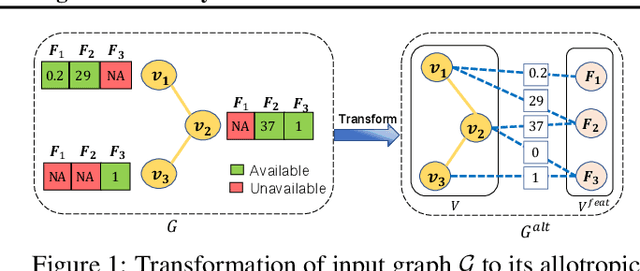

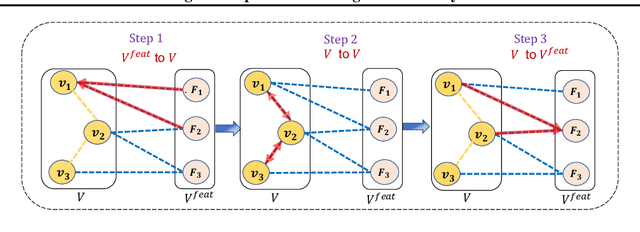
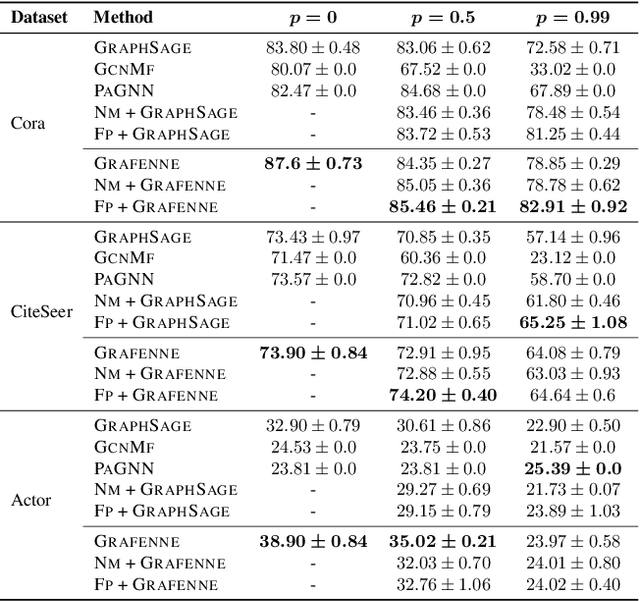
Abstract:Graph neural networks (GNNs), in general, are built on the assumption of a static set of features characterizing each node in a graph. This assumption is often violated in practice. Existing methods partly address this issue through feature imputation. However, these techniques (i) assume uniformity of feature set across nodes, (ii) are transductive by nature, and (iii) fail to work when features are added or removed over time. In this work, we address these limitations through a novel GNN framework called GRAFENNE. GRAFENNE performs a novel allotropic transformation on the original graph, wherein the nodes and features are decoupled through a bipartite encoding. Through a carefully chosen message passing framework on the allotropic transformation, we make the model parameter size independent of the number of features and thereby inductive to both unseen nodes and features. We prove that GRAFENNE is at least as expressive as any of the existing message-passing GNNs in terms of Weisfeiler-Leman tests, and therefore, the additional inductivity to unseen features does not come at the cost of expressivity. In addition, as demonstrated over four real-world graphs, GRAFENNE empowers the underlying GNN with high empirical efficacy and the ability to learn in continual fashion over streaming feature sets.
Embeddings for Tabular Data: A Survey
Feb 23, 2023

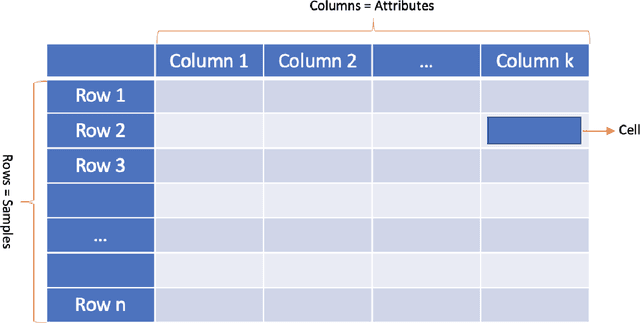

Abstract:Tabular data comprising rows (samples) with the same set of columns (attributes, is one of the most widely used data-type among various industries, including financial services, health care, research, retail, and logistics, to name a few. Tables are becoming the natural way of storing data among various industries and academia. The data stored in these tables serve as an essential source of information for making various decisions. As computational power and internet connectivity increase, the data stored by these companies grow exponentially, and not only do the databases become vast and challenging to maintain and operate, but the quantity of database tasks also increases. Thus a new line of research work has been started, which applies various learning techniques to support various database tasks for such large and complex tables. In this work, we split the quest of learning on tabular data into two phases: The Classical Learning Phase and The Modern Machine Learning Phase. The classical learning phase consists of the models such as SVMs, linear and logistic regression, and tree-based methods. These models are best suited for small-size tables. However, the number of tasks these models can address is limited to classification and regression. In contrast, the Modern Machine Learning Phase contains models that use deep learning for learning latent space representation of table entities. The objective of this survey is to scrutinize the varied approaches used by practitioners to learn representation for the structured data, and to compare their efficacy.
DetAIL : A Tool to Automatically Detect and Analyze Drift In Language
Nov 03, 2022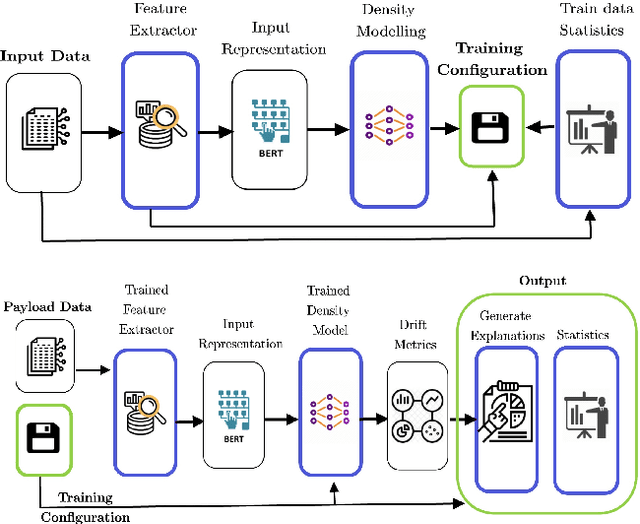

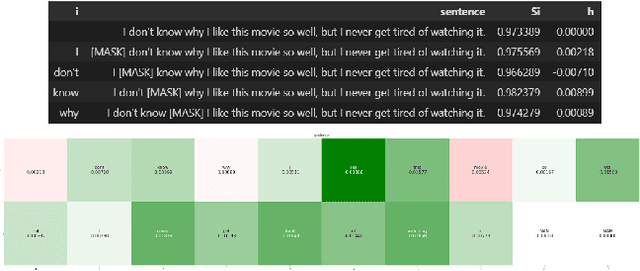
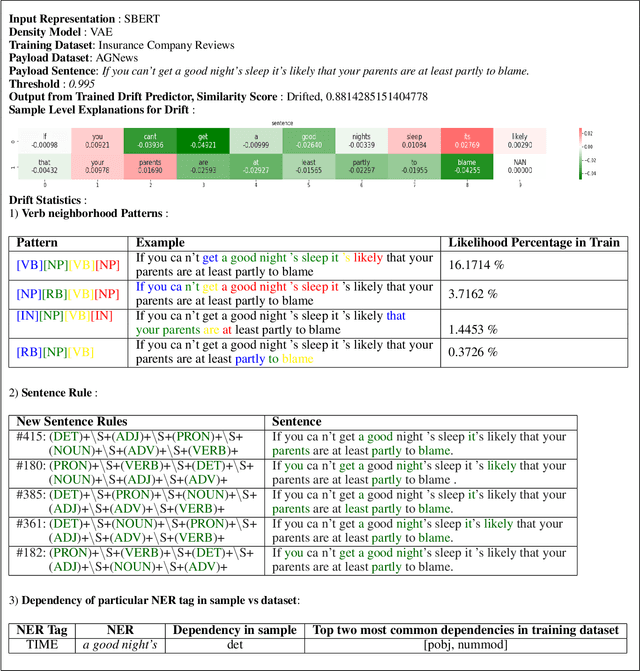
Abstract:Machine learning and deep learning-based decision making has become part of today's software. The goal of this work is to ensure that machine learning and deep learning-based systems are as trusted as traditional software. Traditional software is made dependable by following rigorous practice like static analysis, testing, debugging, verifying, and repairing throughout the development and maintenance life-cycle. Similarly for machine learning systems, we need to keep these models up to date so that their performance is not compromised. For this, current systems rely on scheduled re-training of these models as new data kicks in. In this work, we propose to measure the data drift that takes place when new data kicks in so that one can adaptively re-train the models whenever re-training is actually required irrespective of schedules. In addition to that, we generate various explanations at sentence level and dataset level to capture why a given payload text has drifted.
 Add to Chrome
Add to Chrome Add to Firefox
Add to Firefox Add to Edge
Add to Edge